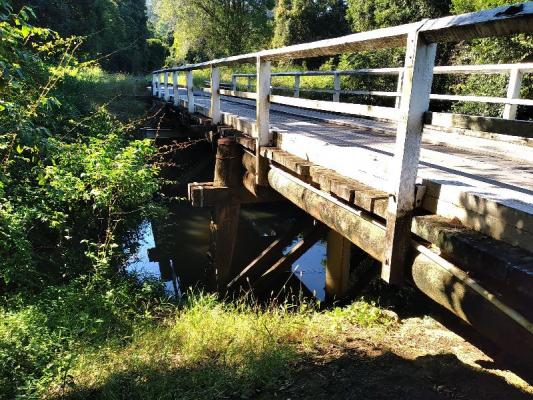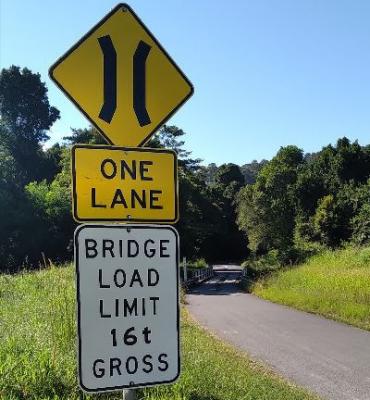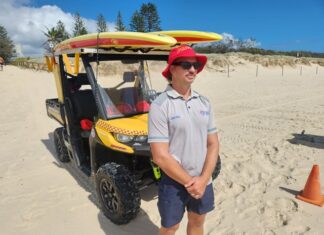Budget blowouts on Kin Kin’s Wahpunga Lane Bridge and Cooran’s Tableland Road Bridge were outlined at a Special Meeting of Noosa Council on Monday.
The projected cost of building a new bridge in Kin Kin has soared by 80 per cent and the Cooran bridge by 40 per cent since the council’s budget was signed off only two months ago.
A report drawn up for the councillors by project coordinator Dennis Luinstra also revealed three significant developments:
1. Early talk of the new bridge being “double lane” has been dropped with the council now referring to a “wider single lane” bridge design.
2. The new bridge will have an unlimited load limit – meaning that large ‘truck and dog’ combinations servicing the nearby Kin Kin Quarry will be able, should they want, to use Wahpunga Lane for runs into the Gympie area for the first time.
3. Previous announcements referring to a 2021 start date for the Wahpunga Lane Bridge (along with even earlier statements in 2019 and 2020) can also be forgotten.
The latest plan sees “an anticipated construction start date” in January 2022 following the completion of the Tableland Road Bridge scheduled for construction from October to December this year.
Readers of the author’s publication Kinnections will be aware that many politicians and government bodies have announced the Wahpunga Lane Bridge Replacement Project over the years – without any of them actually getting round to building it.
Throughout that time, the total project cost has always been set at just over $1.5 million with the funding split evenly between the Federal Government and Noosa Council.
Federal MP Llew O’Brien set the ball rolling when he made the first announcement about the bridge back in May 2019. At that time he said each party would put in $763,661 towards the cost of a new concrete crossing over the Kin Kin Creek.
This same figure was quoted when details of the project were tabled in the Federal Senate hearings in October 2020.
The Queensland Government also used this figure when it included the project in its Queensland Transport and Roads Investment Program 2020/21 – 2023/24.
Most recently, Noosa Council included a total of just over $1.35 million to be spent on the bridge as part of its capital works program in the current financial year 2021/22.
That program was approved and signed off by councillors as part of the council’s Budget process on 30 June – just 61 days before the meeting.
But in his report for the special meeting chaired by Mayor Clare Stewart, Mr Luinstra revealed the project cost has now soared by 78.97 per cent to more than $2.7 million
Officially, there are three principal reasons why the costs have ballooned – and it seems we can blame the Covid-19 pandemic for two of them.
Tenders submitted by four companies hoping to win the contract have come in higher than originally expected because current market saturation – in other words, an increased demand for qualified bridgebuilders – has resulted in tenders “higher than budget“.
The price of steel for construction projects has risen steeply.
An “identified scour issue“ (erosion of the river banks) on the north-east side of the bridge will have to be resolved with steel sheet piling and extended guard rails. This was not included in the original project plans.
The companies bidding for the project have been named as Ark Construction, DavBridge Constructions, Hall Contracting and SGQ.
Having assessed all of the bids, council officials have described SGQ’s submission as the “most favourable“ on a number of grounds including its “experience, capability, and resourcing to carry out the works“.
SGQ also “scored highest for non-price criteria and combined price and non-price criteria“.
Mr Luinstra is recommending the council awards the contract for the bridge renewal to SGQ Pty Ltd.
On 30 June, just 61 days ago, councillors unanimously approved a budget for the current financial year. At that time, the total expected cost of the Wahpunga Lane Bridge project was expected to come in at $1.52 million with $1.35 million of it falling due in 2021/22.
Now, on 30 August, the project cost is sitting at more than $2.7 million – an incredible 78.97 per cent increase.
Well, it turns out that council officials, having discovered the size of the blowout, have already contacted the Federal Government and have sought extra funding under the national Bridewal Program.
And the good news is that the Feds agreed to provide some additional cash on a 50 per cent co-funding from council basis.
They are going to tap into the taxpayer-funded Bridges Renewal Program in order to provide additional funding of nearly $568,000.
Unfortunately, Noosa Council’s application for additional federal funding was made when global steel prices were rising. And the price has continued to rise since then.
So while the application was approved, not all of the extra steel cost will be covered by the national bridge building fund.
And that means the project is no longer a 50-50 deal.
Noosa Council will need to an extra $638,000 compared to the federal share of $568,000 to meet the budget shortfall.
And Noosa’s ratepayers are going to have to cover that.
One item of good news for local residents is that disruption during construction will be kept to a minimum.
“Weather permitting, Wahpunga Lane Bridge will have a relatively short construction duration of 12 weeks, due to the prescribed construction method using mostly prefabricated bolt-on components, combined with a bored piling solution,“ the report states.
“During the temporary road closure, a detour will be made available along Sister Tree Creek Road and Gympie Kin Kin Road.“
Emergency services, local residents and road users will be advised “well up front“ before the contractor introduces detours in advance of the planned bridge deconstruction.
The cost of the proposed Tablelands Road Bridge replacement project has increased by 43 per cent – an extra $409,000. Once again, Canberra will contribute $204,000 towards the budget shortfall but Noosa Council will need to find an extra $206,000 from somewhere.








